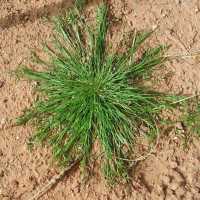Plants annual. Culms 6-27 cm. Ligules 0.3-
Plants annual. Culms 6-27 cm. Ligules 0.3-1.1 mm, of hairs; blades 3-15 cm long, 0.3-1.5 mm wide, abaxial surfaces glabrous or scabrous, adaxial surfaces scabrous, sparsely long-pubescent near the ligules. Panicles 1-6(7.5) cm. Spikelets 4.5-7 mm. Lower glumes 4-5.2 mm, exceeded by the distal florets; upper glumes 4-5.3 mm; lemmas 1.5-2(2.5) mm, with sparse, appressed pubescence between the veins, or glabrous and with spreading hairs on the margins, lobes as wide as or wider than long, acute to obtuse; paleas 1.7-2.2(2.6) mm, those of the lower florets in the spikelets as long as or longer than the lemmas; anthers 0.2-0.4 mm. Caryopses 0.6-0.8 mm. 2n = 12.
Schismus barbatus is native to Eurasia, but it is now established in the southwestern United States. It grows in sandy, disturbed sites along roadsides and fields and in dry riverbeds.
Annuals, Terrestrial, not aquatic, Stems nodes swollen or brittle, Stems geniculate, decumbent, or lax, sometimes rooting at nodes, Stems caespitose, tufted, or clustered, Stems terete, round in cross section, or polygonal, Stem internodes hollow, Stems with inflorescence less than 1 m tall, Basal leaves equal to or exceeding stems, culms, or scapes, Stems, culms, or scapes exceed ing basal leaves, Leaves mostly basal, below middle of stem, Leaves conspicuously 2-ranked, distichous, Leaves sheathing at base, Leaf sheath mostly open, or loose, Leaf sheath smooth, glabrous, Leaf sheath hairy at summit, throat, or collar, Leaf sheath and blade differentiated, Leaf blades linear, Leaf blades very narrow or filiform, less than 2 mm wide, Leaf blades mostly flat, Leaf blade margins folded, involute, or conduplicate, Leaf blades mostly glabrous, Leaf blades scabrous, roughened, or wrinkled, Ligule present, Ligule a fringe of hairs, Inflorescence terminal, Inflorescence a contracted panicle, narrowly paniculate, branches appressed or ascending, Inflorescence solitary, with 1 spike, fascicle, glomerule, head, or cluster per stem or culm, Inflorescence branches more than 10 to numerous, Flowers bisexual, Spikelets pedicellate, Spikelets laterally compressed, Spikelet less than 3 mm wide, Spikelets with 3-7 florets, Spikelets with 8-40 florets, Spikelets solita ry at rachis nodes, Spikelets all alike and fertille, Spikelets bisexual, Inflorescence disarticulating between nodes or joints of rachis, rachis fragmenting, Spikelets disarticulating above the glumes, glumes persistent, Spikelets disarticulating below the glumes, Spikelets disarticulating beneath or between the florets, Rachilla or pedicel glabrous, Glumes present, empty bracts, Glumes 2 clearly present, Glumes equal or subequal, Glumes equal to or longer than adjacent lemma, Glumes 3 nerved, Glumes 4-7 nerved, Lemmas thin, chartaceous, hyaline, cartilaginous, or membranous, Lemma 5-7 nerved, Lemma 8-15 nerved, Lemma body or surface hairy, Lemma apex dentate, 2-fid, Lemma awnless, Lemma mucronate, very shortly beaked or awned, less than 1-2 mm, Lemma margins thin, lying flat, Lemma straight, Lemma surface pilose, setose or bristly, Palea present, well developed, Palea membranous, hyaline, Palea about equal to lemma, Palea 2 nerved or 2 keeled, Stamens 3, Styles 2-fid, deep ly 2-branched, Stigmas 2, Fruit - caryopsis.
Common Name: common Mediterranean grass
Duration: Annual
Nativity: Non-Native
Lifeform: Graminoid
General: Low tufted annual grass, 10-20 cm tall, glabrous, erect to spreading or semiprostrate.
Vegetative: Leaves mostly basal; blades soft, bright green, narrow, 3-15 cm long, to 1.5 mm wide; sheath with membranous border above, often broad and truncate at apex; ligule a ring of short and long hairs.
Inflorescence: Terminal, dense, compact panicles, 1-6 cm long; spikelets 5-7 mm long, 5-7 flowered; glumes 2.5-4.5 mm long, acute or acuminate, with hyaline margins; lemma five-nerved, with a shallow or minute apical notch, pubescent between the veins or glabrous and with spreading hairs on the margins; palea about as long as lemma. Disarticulation initially above the glumes, the glumes and pedicels sometimes falling together later.
Ecology: Found on dry open ground, often in disturbed soil below 4,000 ft (1219 m); flowers January-May.
Distribution: Native to Eurasia; introduced throughout the world; in N. Amer. it is found in the southwestern states, CA, s NV, s UT, AZ, s NM, sw TX; south to c MEX.
Notes: A small, low-growing, introduced annual bunchgrass distinguished by its growth form of often hugging the ground; spikelets of multiple florets; the lemmas possessing long, soft hairs, a rounded apex with two acute lobes, and semi-clear margins and tips. Distinguished from S. arabicus by its glumes which are shorter than the total spikelet length; lemma lobes wider than they are long; and paleas as long as the lemmas. S. arabicus has glumes which exceed the last floret; lemma lobes longer than they are wide; and paleas shorter than the lemmas. The two species are thought to intergrade.
Ethnobotany: Unknown
Etymology: Schismus is from Greek schismos, cleaving, referring to the split lemma; barbatus means bearded, referring to the hairy lemmas.
Synonyms: Festuca barbata, Schismus calycinus
Editor: SBuckley 2010, FSCoburn 2015, AHazelton 2015




